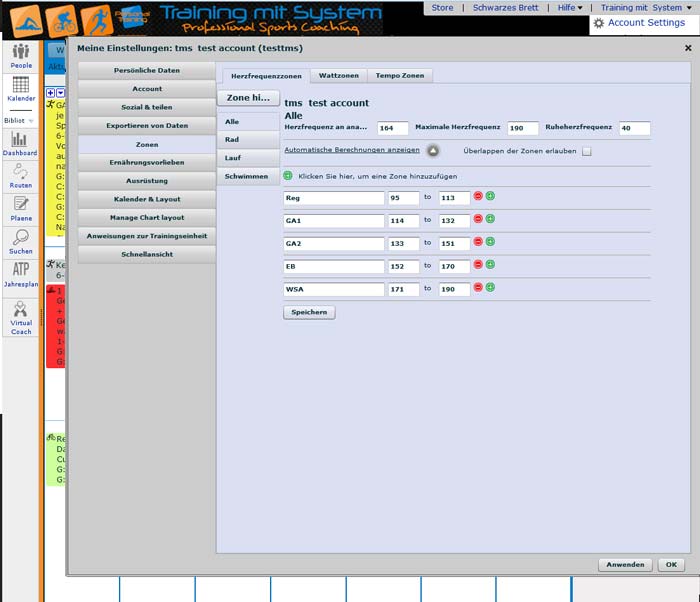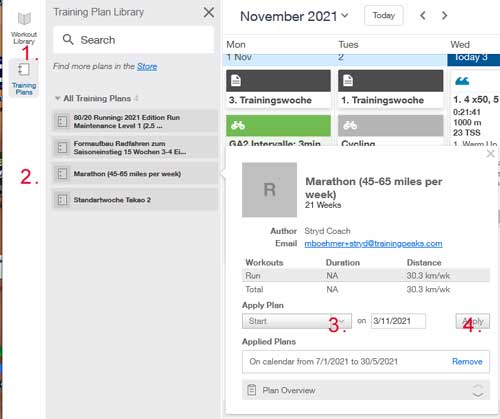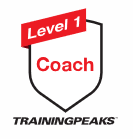3. FAQ - Questions about our training process
- 1. What training zones are existing and what are they designed for?
- 2. Where can I find my training zones and how can I find them?
You can find the training zones by clicking on the name in the upper right corner of the account, here a menu "Account Settings" opens
In the opening window under Zones you will find the training zones and their assigned heart rates or power zones (watts & speed zones).
Please note that it is possible to assign different heart rates to the training zones for different sports.
Athletes without a coaching option must adjust these training areas themselves. Instructions can be found here in the corresponding section under the different sports.
- 3. What training methods are existent and what are they used for?
SE - Steady Effort
Training method primarily to improve basic endurance, aerobic capacity and long-term endurance. The continuous method is characterized by the fact that the endurance load is steady and without pause. The endurance method improves endurance performance.
FS - Fartlek
In the driving game, the adaptation of the speed takes place through situation-adapted (subjective condition, terrain) speed change of the athlete. The distances and the load intensity can be freely selected according to the requirements.
IM - Interval Method (tempo alternation)
Training method to improve endurance, which is characterized by systematic alternation of stress and relief. The interval method is characterized by the fact that the load is interrupted by load pauses.
WM - Repetition Method
With the repetition method, a distance is repeated several times, an almost complete recovery usually takes place in between the repetitions. Usually an under distance is denied, in order to be able to cover all repetitions with competition speed or faster.
- 4. What is the structure of the training session?
The basic setup of a training Session:
1. Warm up (running, running, swimming)
2. Main set
3. Cool down (running, running, swimming)
All heart rates, power or speed values are output individually *
* Prerequisite is that the test values achieved in the Test sessions are transferred accordingly.
Bike ore Run Session setupWarm up
- 5:00 min @ 129 - 135 1/minRepeat 10 x
- 5:00 min Z2 easy @ 137 - 146 1/min - Z2
- 5:00 min Z3 middle @ 149 - 161 1/min - Z3Repeat 5 x
- 4:30 min Z2 easy @ 137 - 146 1/min - Z2
- 0:30 min technique drills @ 137 - 161 1/min - Z3Cool Down
- 5:00 min @ 129 - 135 1/min
Swim Session setupWarm up
- 300 m @ 01:49-01:53 sec/100m .Repeat 6 x
- 50 m (25m technique - 25m loose) @ 01:41-01:49 sec/100m - loose - Z2
- Rest 30 sec @ 00:00 sec/100mRepeat 2 x
- 200 m @ 01:37-01:43 sec/100m - medium - Z3
- Rest 30 sec @ 00:00 sec/100m400m - maximum speed
- 400 m @ 01:30-01:31 sec/100m fast - Z5Repeat 10 x
- 50 m Medium (alternating with and without Pb (Pull Bouy)) @ 01:23-01:30 sec/100m very fast - Z6
- rest 45 sec @ 00:00 sec/100mCool Down
- 200 m @ 01:49-01:49 sec/100m - Z1 - 5. What about stretching and stabilization training?
Stretching should be part of every training day routine.
There are many forms of stretching, you should find the right one for you and incorporate it into your daily routine.Stabilization training should also be part of the general training program.
Stretching or Stabilization/strength training is entered in the category "Strength/strength training" in the training protocol.
- 6. What are test sessions and what is the purpose of it?
These special sessions are planned several times during the season/training plan and serve as a reference for performance comparison and adjustment of your training zones.
Further information can be found at later here.
- 7. Which technique drills do we recommmend for swimming?
Which technique drills do we recommend for swimming?
- 8.Which technical drills do we recommend for cycling?
All exercises and videos can be found here(technique drills biking).
- 9. Which technical drills do we recommend for running?
All exercises and videos can be found here(technique drills running).
- 10. Recommendation to adapt individual training sessions to your current needs.
Since not everything fits 100% in training and in life, you will find some information to adjust the plan to your needs.
The training session in the plan are structured and systematically built on each other. If the plan is simply too light, too short or too heavy or the perfect weather forces you to make a longer bike ride :-) can make the following adjustments.
For athletes with the coaching option, the coach writes the plan and minor adjustments should only be necessary on a daily basis due to weather changes or short-term plan changes.
Individual adjustment possibilities of the unit length Running and cycling
long and easy training session with a very high Z2 percentage
Add the appropriate time in Z2 tempo to the end of the training session and/or extend the number of intervals contained accordingly.
Never extend the session by more than 30%.
more intensive training session Z3/ Z4/Z4/Z5-6
Do not try to lengthen units by extending the rest time between the intensive intervals, this will change the character of the training in most cases and may be counterproductive.
Option 1
Please make sure that the more intensive interval time is never 20% longer than the target distance and or time in your target race or that the intensive training time is only extended by max. 20%. Example bike split in the Olympic distance 90 minutes - maximum allowed intensive interval time 108 minutes (90min+18min).Example: Calculation
Original unit:
Repeat 10 x (5min Z2 - 5min Z3)
Calculation 10 x 5min Z3 = 50 min intensive total interval time
Extension by max. 20% of 50min = 10min ⇾ Thus, a maximum of 2 (x 5min) additional intervals may be added.Option 2
Single Session or second training in Brick Training: Continue the training after completing the intervals in Z2 pace Steady Effort to extend.Brick Training : Extend the training before you start the given intervals Z2 pace Steady Effort to slightly influence the load profile before the transition.
SwimmingDepending on the training content you can add/remove several repetitions of the main set,
Shorten: Cut down the length of the swim intervals is preferred first
Extend: Increasing the number of repetitions is preferablySample unit:
1. Warm Up
300 @ 01:49-01:53 sec/100m/y Warm Up.2. Repeat 2 x technique
- 50.0 @ 01:41-01:53 sec/100m/y - easy
- rest 30 sec @ 00:00 sec/100m/y3. Repeat 2 x Options to extend 2 x 250 or 300
- 200.0 @ 01:37-01:43 sec/100m/y - medium
- rest 30 sec @ 00:00 sec/100m/y4. 400 - maximum speed Options to extend 500, shortening option 300 or 200
- 400 m @ 01:30-01:31 sec/100m/y fast5. Repeat 10 x Options to extend 12 x 50 or 20 x 50 , shortening option 10 x 25
- 50 medium with and without PB alternating @ 01:23-01:30 sec/100m/y very fast
- Pause 45 sec @ 00:00 sec/100m/y6. Cool Down
200 m @ 01:49-01:53 sec/100m/y - RecoveryIn the first weeks the training is held more relaxed, partly the swimming units contain a specification for the extension of the unit, if available this should be used.
Open Water / Open Water SwimmingIn the last training weeks before the race the training explicitly contains Open Water units.
If these cannot be done in open water, the training should be done in the swimming pool or outdoor pool.
If it is assumed that there is NO wetsuit allowed in the race, you should swim here in competition clothes (e.g. swimsuit).
Option 1 - Training in the swimming pool instead of Open Water
Whole or partly with neoprene suit, the Wetsuit can be worn here at least possibly in the outdoor pool only at the beginning, here please pay attention to the body temperature and take off Neo early.
As a substitute for the simulation of the neoprene suit you should always swim with pull buoy to simulate the load. Unless the race takes place without neoprene release.
Option 2 - Training in Open Water instead of swimming pool
This option should be used whenever possible. Here the given training has to be built into an open water swimming as exactly as possible.
Possible adjustments:
Break times as actual swimming breaks or very relaxed swimming.
Always built in some acceleration and intervals in a calm swimming.
Exchange of training session between training daysThe exchange of training session is something quite normal and is possible.
In a training plan with less weekly volume, this is much easier due to time constraints.
Swimming units are always quite easy to swap. This makes sense if the swimming pool operation time is better suited for a different sequence of exercises or if a training session is better suited for open water swimming.
In addition, a swimming unit can always be placed on the recovery day, ensure that at least one recovery day is not used or only strength and stabilization training is planned.When exchanging session, make sure that the intensive training (Z3-Z6) are not trained on the same day or that an accumulation of intensive training occurs and the recovery between the training is given.
Brick session should be maintained as much as possible.The weekend training should preferably always be exchanged as a block, on a daily basis.
You can only make up for missed training sessions in the following 3 days if no recovery day or another training in this sport is missed.
If you have premium access to TrainingPeaks, you can also move future units, with a basic access this only works with past units.
- 11. How does the training plan or TrainingPeaks recognize an improvement in performance and how can I train with the resulting training zones and load?
TrainingPeaks does not detect any improvement in performance or does not automatically adjust training zones.
TrainingPeaks provides the data to detect a change in the performance. We as trainers can interpret this data with our experience and can change the training areas in consultation with the athlete.
As an athlete with a training plan, you have the possibility to do the tests that are usually repeated every 12 weeks and then, with the help of our instructions, convert the test results into a threshold value.
After you have entered this value in the TrainingPeaks settings of the corresponding sport, they are then converted into new training zones and used automatically in the following training sessions. - 12. How can I set a realistic target time for my race?
Indeed, this is a difficult question and cannot be answered satisfactorily in all cases.
In any case, we need your test results, e.g. from the tests that we include in the training plans and that are repeated after about 12 weeks, and significant training results that are comparable for the competition. These, we can see if the "athlete account" is shared with our "coach account".
Send us a request and we will help you to predict or orientate for a target time. - 13. How do I recognize the periodization in my training plan?
In every training plan provided via TrainingPeaks, an individual instruction for the specific training plan is available to download on Monday of the second week. In this PDF both the weekly training hours are shown in table form and the corresponding training priorities of the corresponding current training block.
In addition, many other details of the training plan are provided and explanations are given.
- 14. How can I reuse a training plan or move the end date?
If the training plan is purchased through us.
Then email us and we will move the plan.
If training plan is purchased through TrainingPeaks.
1. In your account on the left side, go to training plans (Training Plan), reuse training plan.
2. Open the corresponding plan
3. Choose the new start or end date and confirm with "Apply".
4. Confirm with "Apply
After that, the plan is reassigned again.
If this does not work, please contact us.
- 15 Should I adjust the training sessions for the indoor trainer?
On the indoor trainer it is usually a little more strenuous than outdoors, both pulse and wattage values can differ, if necessary, you should test yourself here separately for a different the threshold. We have had athletes where the values differ by more than 10%. I always recommend making the conditions as equal as possible, same bike and as much ventilation as possible. If the bikes are different, the seat position and crank length should be as identical as possible. Now the factor load comes in addition, yes you can say on the ergometer / indoor trainer it is harder, because you have less break times by rolling or standing, and you do not move dynamically. I would not shorten the duration, I would see it as "additional training".













